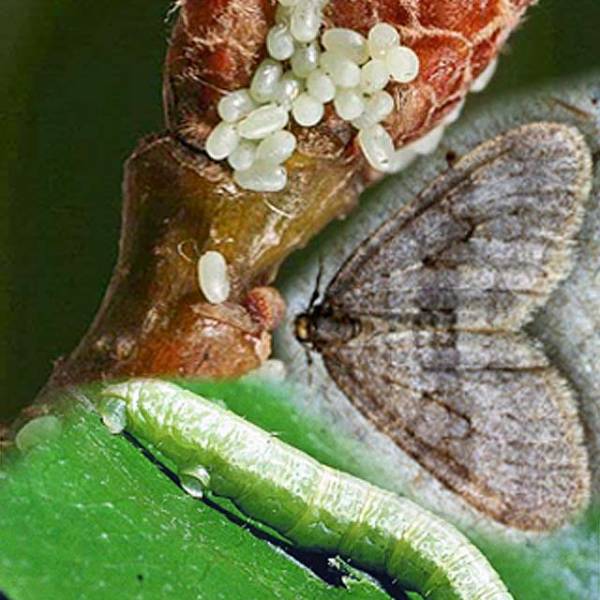
You’ve probably noticed them around your porch light at night– swarms of grey-winged moths clinging to screens and siding on early winter evenings. These are adult Operophtera brumata, commonly known as Winter Moth. These insects are an invasive import from Nova Scotia that has gained a foothold in our region in recent years. Warm weather in late fall has exacerbated the issue and ballooned their numbers, leading to dozens of calls and reports from gardeners who are concerned about the repercussions in Spring once the eggs have hatched.
The male of the species has wings and can fly; females do not. While the boys are busy swarming around your porch light on December nights, the lady moths creep along the bases of trees and buildings to lay their eggs. This is one of the areas you will need to target in the Spring in order to control the invasion.
In March & April the eggs hatch into inchworm larvae, which spin threads of silk and drift up into the tree canopies. By late April they will have begun to wreak havoc on your trees, burrowing into fresh buds and devouring new leaves. At this point it becomes exponentially more difficult to control them, and they can defoliate a healthy tree in a number of days.
Apple, ash, basswood, birch, cherry, crabapple, elm, maple, and oak are particularly susceptible; fortunately most shrubs (with the exception of blueberries) are mostly exempt from destruction.
So what can you do? Plenty!
In December: Check around your home’s foundation and the bases of your trees for areas where females are likely to lay eggs. They like to hide in crevices, laying their eggs in protected nooks under lichen and debris. There is not a lot you can do about the eggs themselves, but you can make note of these areas for next Spring.
In early March: Check those moth hideouts again! As the larvae are hatching, apply Bonide Thuricide, which contains Bacillus thuringiensis (B.t. Kurstaki). This is a bacterium that works well on small young Winter Moth larvae- basically, you’re creating a moth disease epidemic and killing them at the source.
In March & April: The larvae will have grown larger and will be on the move up into your trees. Target feeding areas with a spinosad-based insecticide, such as Captain Jack’s Deadbug Brew from Bonide. Evening is the best time to spray, because you don’t want to do any harm to the bees and beneficial insects that may be actively visiting your plants. Make sure you help any damaged trees by watering deeply once a week so that they can put out new leaves.
May: This is the active feeding time. Keep spraying Captain Jack’s, or switch things up with a pyrethrin-based contact insecticide like Bonide’s Eight. Continue to water damaged trees once a week.
June: The feeding frenzy should be mostly over, and the caterpillars will retreat into the soil to pupate and become adult moths. Continue watering any trees throughout the summer so that they can re-establish their leaves and recover.
Related articles & information:
Weston Nurseries Blog Archive: Winter Moth Larvae are Upon Us
Mass Audubon: Winter Moths
U Mass Extension: Winter Moth ID & Management









